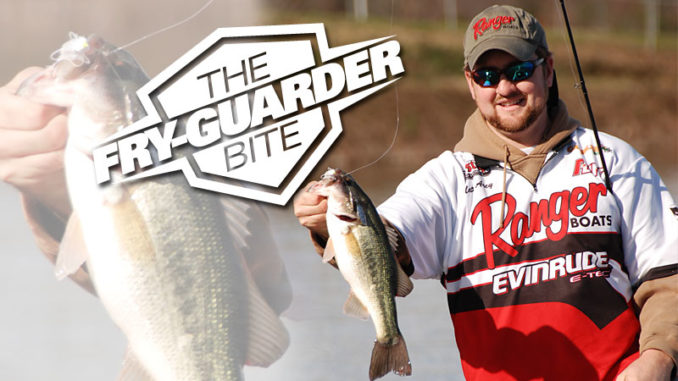
Post-spawn bass fishing can be some of the most challenging
The big sows that were hungry and attacked everything in sight a couple of weeks ago are weary and frazzled from the bedding and spawning process. These post-spawn bass can be tough to catch.
Depending on where you live in the Carolinas, the typical seasonal progression is to go from prespawn fishing to bed fishing and then to a pattern that takes advantage of the shad or herring spawn. But what about those years when weather patterns or water patterns put some distance between bedding bass and spawning herring?
According to bass pro Matt Arey from Shelby, N.C., you might be able to find enough decent-sized bass by looking for both male and female fish that are protecting their offspring.
He refers to this tactic as the “fry guarder bite.”
“Sooner or later, this pattern will apply everywhere on lakes across both Carolinas. It just depends on the timing of that (particular) lake,” Arey said. “There are a few signs, but you have to look for them.”
The first tell-tale sign is easing up into a shallow cove and seeing empty beds. If the water is clear enough, it looks like a ghost town. The party is over, and there’s nothing left but the mess.
Bass are likely still close by
In reality, this is not true. Arey said although the beds might be empty, it doesn’t mean bass aren’t still around. In fact, tons of bass may be present. They’re just too small to see.
“A lot of times you can pull into an area, and you’ll see the fry scatter across the surface,” he said. “Look closer, and you’re likely to see a bass that’s not stuck to the bed. But he’s circling the area, doing figure 8s in the water.”
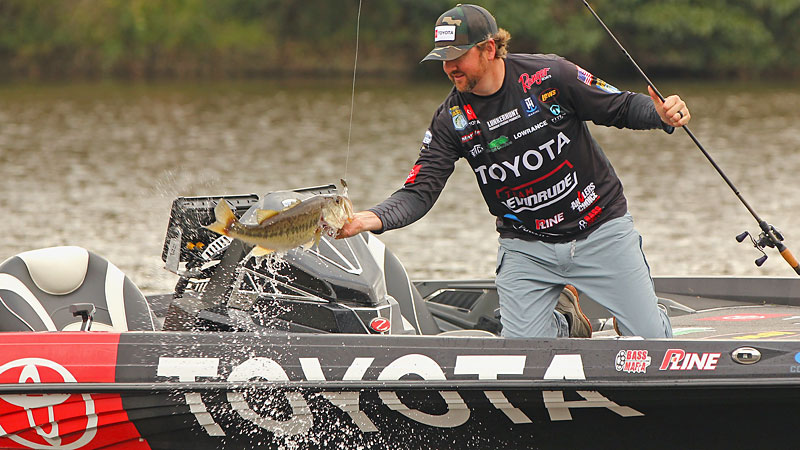
Those figure 8 swimming patterns are two-fold. The first is a sheepherder’s instinctive attempt to keep the fry corralled up. The second is a territorial sweep to keep predators out.
“In the Carolinas, seeing fry guarders is a sure sign the spawn is over,” Arey said. “Our lakes are not like some other locations where you have multiple waves of spawning. Here, when they’re done, it’s over.”
Males and females both guard fry
Although other environmental conditions may dictate, Arey generally sees bass guarding fry by May 1. Contrary to popular belief, it’s not just males guarding the young, either. He has caught plenty of hefty females that stuck around to tend to the young.
When practicing for a tournament, he may not even try to catch fry guarders. But he likes knowing they are there. He said scouting is important, and he likes knowing the whereabouts of a couple of areas that are rich in post-spawn life. He may not see the fish he’s after, but he likes knowing the stage is set.
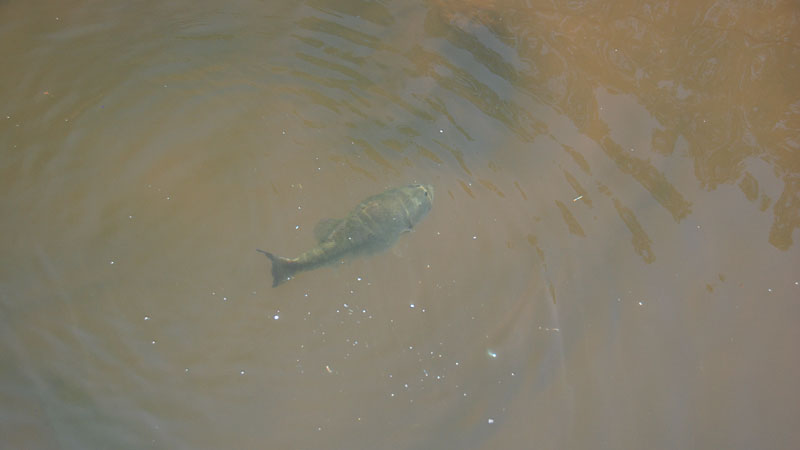
Fry-guarders are very much like bedding fish
Arey approaches fry-guarders in a manner similar to bedding fish. He uses a three-prong, four-bait rotation to catch these fish.
A topwater lure, either a popper or a prop bait, starts things off. Arey stays well back and makes long casts to the areas he’s scouted in practice. He may or may not get a bite on the topwater bait. But he often gets a reaction.
“Bream are the No. 1 predator of bass fry. So you want to match the hatch with your baits,” he said. “If I don’t catch the bass on topwater, I’ll switch over to a swimbait and roll that just under the surface.”
If he still hasn’t connected, he’s going to make a decision. He’ll either come back later and try again or get out the spinning rod. His fourth bait is a wacky rigged plastic worm that he uses to chase the fry, attempting to agitate the guardian.
Utilize a little patience, but only a little
“Bear in mind, I’m not going to spend all day on one fish,” he said. “It’s very similar to bed-fishing in that I’ll know if I can catch that fish in the first 5 minutes. If I do feel I can catch it, and the fish is big enough to be worth the effort, I might commit 15 minutes.”
Speaking of size, Arey said by the time he’s made a few casts, he’s generally gotten some reaction. He’s seen the fish, and the fish has seen him. And both know the game is afoot.
“Some days, a fry guarder bite is all you’ve got. You need to capitalize on them while you can,” he said. “Generally, the overall weights of all the bass are going to be down. But if you can’t find any spawning fish, and the local shad or herring bite hasn’t started up good yet, this may be the best way to catch the fish you can catch on a given day.”
Matt Arey’s ‘fry-guarder’ arsenal
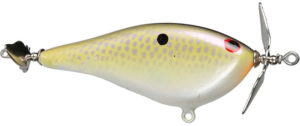
After a few days on a lake, bass pro Matt Arey can tell in which stage of the spawn bass are on most lakes in the Carolinas. If that includes targeting bass guarding fry in the general bedding area, he’s going to rig four rods with four different baits.
- The No. 1 rod is for a topwater bait. Arey’s first choice is a Lunkerhunt Impact Crush Popper, a 2½-inch, 1/3-ounce surface bait. His go to colors are Silverside and Sassy. He fishes the bait on 12-pound P-Line copolymer. He prefers it to fluorocarbon because he likes the line to float when he’s throwing a topwater bait. His rod is a 7-foot, medium-action Lew’s Custom Pro baitcaster that is paired with a Lew’s Hyper Mag reel with a 7:1 retrieve ratio.
He’s going to make long casts and work the bait back to the boat using a walk-the dog retrieve.
Other setups for post-spawn bass
- Setup No. 2 includes the same rod, reel and line combo, except that he’ll tie on a Brian’s Bees Prop Bee, a bait made in North Carolina by Brian Huskins. It’s a balsa with flat sides that has the general look of a bluegill.
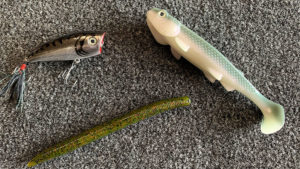
Arey fishes this bait with a series of twitches and pops to imitate a bluegill eating bass fry.
- The third rod is a 7-foot-6 heavy action Lew’s Custom Pro baitcaster, paired with the same Lew’s reel, this time spooled with 20-pound P-Line fluourcarbon and tied to a Lunkerhunt Fetch swimbait, a 4½-inch model rigged with a 6/0 Gamakatsu Superline hook. Neither the bait or the hook is weighted. Preferred colors are greenback and bluegill.
Arey uses a simple, slow and steady retrieve, allowing it to roll just under the surface.
- The fourth rod is a medium-action, Lew’s Custom Pro spinning rod that’s paired with a Lew’s Custom Pro Speed Spin spinning reel spooled with 10-pound P-Line PCB braid. He ties in a 2-foot leader of 10-pound fluorocarbon and uses a Lunkerhunt Lunkerstick, a worm that’s rigged wacky style on a Gamakatsu Superline 3/0 hook. Arey pitches this into the fry school and chases the fish with the lure. His favorite color is watermelon red.




Be the first to comment